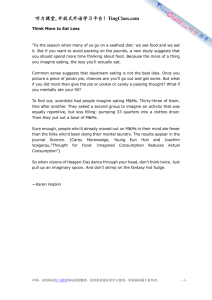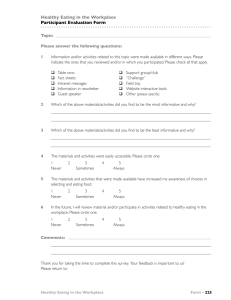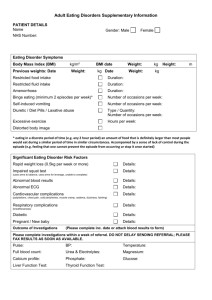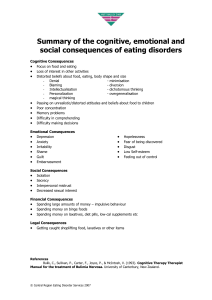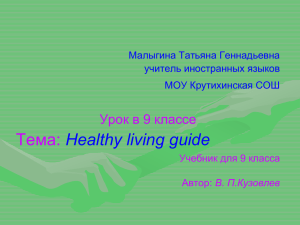Eating Pathology Symptoms
advertisement
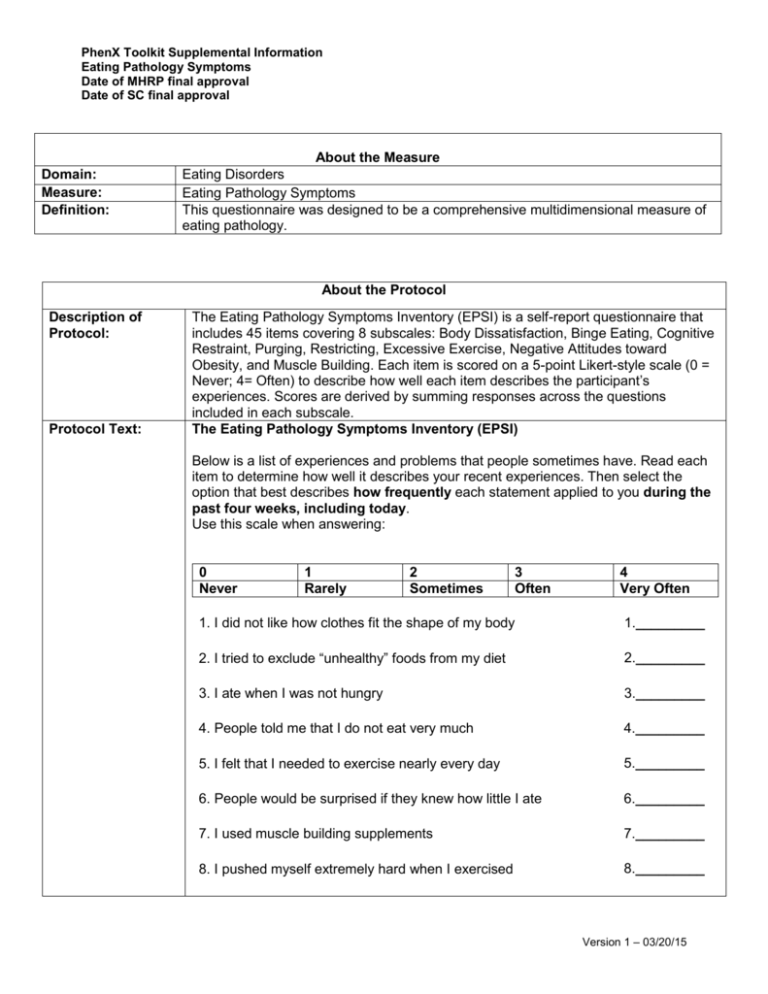
PhenX Toolkit Supplemental Information Eating Pathology Symptoms Date of MHRP final approval Date of SC final approval Domain: Measure: Definition: About the Measure Eating Disorders Eating Pathology Symptoms This questionnaire was designed to be a comprehensive multidimensional measure of eating pathology. About the Protocol Description of Protocol: Protocol Text: The Eating Pathology Symptoms Inventory (EPSI) is a self-report questionnaire that includes 45 items covering 8 subscales: Body Dissatisfaction, Binge Eating, Cognitive Restraint, Purging, Restricting, Excessive Exercise, Negative Attitudes toward Obesity, and Muscle Building. Each item is scored on a 5-point Likert-style scale (0 = Never; 4= Often) to describe how well each item describes the participant’s experiences. Scores are derived by summing responses across the questions included in each subscale. The Eating Pathology Symptoms Inventory (EPSI) Below is a list of experiences and problems that people sometimes have. Read each item to determine how well it describes your recent experiences. Then select the option that best describes how frequently each statement applied to you during the past four weeks, including today. Use this scale when answering: 0 Never 1 Rarely 2 Sometimes 3 Often 4 Very Often 1. I did not like how clothes fit the shape of my body 1._________ 2. I tried to exclude “unhealthy” foods from my diet 2._________ 3. I ate when I was not hungry 3._________ 4. People told me that I do not eat very much 4._________ 5. I felt that I needed to exercise nearly every day 5._________ 6. People would be surprised if they knew how little I ate 6._________ 7. I used muscle building supplements 7._________ 8. I pushed myself extremely hard when I exercised 8._________ Version 1 – 03/20/15 PhenX Toolkit Supplemental Information Eating Pathology Symptoms Date of MHRP final approval Date of SC final approval 9. I snacked throughout the evening without realizing it 9._________ 10. I got full more easily than most people 10._________ 11. I considered taking diuretics to lose weight 11._________ 12. I tried on different outfits, because I did not like how I looked 12._________ 13. I thought laxatives are a good way to lose weight 13._________ 14. I thought that obese people lack self-control 14._________ 15. I thought about taking steroids as a way to get more muscular 15._________ 16. I used diet teas or cleansing teas to lose weight 16._________ 17. I used diet pills 17._________ 18. I did not like how my body looked 18._________ 19. I ate until I was uncomfortably full 20. I felt that overweight people are lazy 19._________ 20._________ 21. I counted the calories of foods I ate 21._________ 22. I planned my days around exercising 22._________ 23. I thought my butt was too big 23._________ 24. I did not like the size of my thighs 24._________ 25. I wished the shape of my body was different 25._________ 26. I was disgusted by the sight of an overweight person wearing tight clothes 26._________ 27. I made myself vomit in order to lose weight 27._________ 28. I did not notice how much I ate until after I had finished eating 28._________ 29. I considered taking a muscle building supplement 29._________ 30. I felt that overweight people are unattractive 30._________ Version 1 – 03/20/15 PhenX Toolkit Supplemental Information Eating Pathology Symptoms Date of MHRP final approval Date of SC final approval 31. I engaged in strenuous exercise at least five days per week 31._________ 32. I thought my muscles were too small 32._________ 33. I got full after eating what most people would consider a small amount of food 33._________ 34. I was not satisfied with the size of my hips 34._________ 35. I used protein supplements 35._________ 36. People encouraged me to eat more 36._________ 37. If someone offered me food, I felt that I could not resist eating it 37._________ 38. I was disgusted by the sight of obese people 38._________ 39. I stuffed myself with food to the point of feeling sick 40. I tried to avoid foods with high calorie content 39._________ 40._________ 41. I exercised to the point of exhaustion 41._________ 42. I used diuretics in order to lose weight 42._________ 43. I skipped two meals in a row 43._________ 44. I ate as if I was on auto-pilot 44._________ 45. I ate a very large amount of food in a short period of time (e.g., within 2 hours) 45._________ EPSI Scoring Directions: Sum the scores for individual items for each scale Body Dissatisfaction #1, #12, #18, #23, #24, #25, #34 Binge Eating #3, #9, #19, #28, #37, #39, #44, #45 Cognitive Restraint #2, #21, #40 Purging Version 1 – 03/20/15 PhenX Toolkit Supplemental Information Eating Pathology Symptoms Date of MHRP final approval Date of SC final approval #11, #13, #16, #17, #27, #42 Restricting #4, #6, #10, #33, #36, #43 Excessive Exercise #5, #8, #22, #31, #41 Negative Attitudes toward Obesity #14, #20, #26, #30, #38 Participant: Source: Personnel and Training Required: Equipment Needs: Muscle Building #7, #15, #29, #32, #35 Adolescents and adults, ages 14 and older Forbush, K. T., Wildes, J. E., & Hunt, T. K. (2014). Gender norms, psychometric properties, and validity for the Eating Pathology Symptoms Inventory. International Journal of Eating Disorders, 47(1), 85–91. Forbush, K. T., Wildes, J. E., Pollack, L. O., Dunbar, D., Luo, J., Patterson, K., Petruzzi, L., Pollpeter, M., Miller, H., Stone, A., Bright, A., & Watson, D. (2013). Development and validation of the Eating Pathology Symptoms Inventory (EPSI). Psychological Assessment, 25(3), 859–878. None None Protocol Type: Self-administered questionnaire General References: Watson, D., O’ Hara, M. W., Simms, L. J., Kotov, R., Chmielewski, M., McDadeMontez, E. A., Gamez, W., & Stuart, S. (2007). Development and validation of the Inventory of Depression and Anxiety Symptoms (IDAS). Psychological Assessment, 19, 253–268. doi:10.1037/1040-3590.19.3.253 Williams, G.-J., Power, K. G., Miller, H. R., Freeman, C. P., Yellowlees, A., Dowds, T., Walker, M., & Parry-Jones, W. L. (1994). Development and validation of the Stirling Eating Disorder Scales. International Journal of Eating Disorders, 16, 35–43. doi:10.1002/1098-108X(199407)16:13.0.CO;2-4 Williamson, D. A., Barker, S. E., Bertman, L. J., & Gleaves, D. H. (1995). Body image, body dysphoria, and dietary restraint: Factor structure in non-clinical subjects. Behavior Research and Therapy, 33, 85–93. doi:10.1016/0005-7967(94)E0031-D Version 1 – 03/20/15



